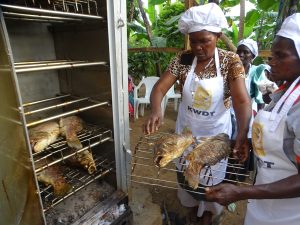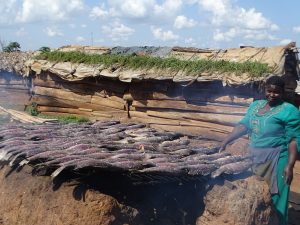Greater support is needed for the adoption of a safe and effective fish smoking technology, associated with numerous positive socio-economic outcomes
By Margaret Nakato, (katosiwomen@katosi.org), Katosi Women’s Development Trust, Uganda
Smoking fish is one of the most common methods of food preservation among fishing communities in Uganda. The most common species that fishing communities smoke include Nile Perch and Tilapia. However, one of the main hazards associated with traditional smoking methods is the risk of cancer due to Polycyclic Aromatic Hydrocarbons (PAHs), which are cancer causing compounds, generated in traditional fish smoking processes. The PAHs are a result of burning toxic compounds present in the firewood used for smoking fish. Consistent exposure to PAHs has been linked to increased incidences of lung, skin, and bladder cancers. In this context, the introduction of a new technology, the NARO PAH Safe Fish Smoking Kiln, comes as a boom to the at-risk population of women fish smokers. Invented by the National Agricultural Research Organization (NARO), the NARO PAH Safe Fish Smoking Kiln, does not only improve the quality of smoked fish products but dramatically reduces PAH levels, making fish smoking a much safer occupation.
The kiln consists of three chambers; the smoking chamber, filtration chamber and the dehydration chamber. The smoking chamber produces the smoke which goes through the smoke delivery pipe to the filtration chamber. At the filtration chamber, the bad smoke is separated from the good smoke which goes to the dehydration chamber. The good smoke passes on to the fish towards the outlet giving the fish a golden-brown color and smoky aroma. The bad smoke is retained at the lower part of this filtration chamber and drained out in liquid form. This smoke is high in PAH content. The smoking process is completed through heat generated from charcoal trays beneath the dehydration chamber.

Beyond health benefits, the NARO PAH-Safe Fish Smoking Kiln has improved the working environment of fish processors. Globally, fish processing is a female dominated sector but many women fish processors, often with the children under their care, have for decades suffered the adverse effects of smoking fish using open fire kilns. Studies show that PAHs are particularly toxic to breast feeding mothers, and improving their working conditions is essential for the health of the mother and children. The kiln creates a smoke-free environment and reduces exposure to burns. Traditional smoking methods forced women to spend nights monitoring the processing to ensure that the fish didn’t get burnt. The NARO PAH Safe Fish Smoking Kiln reduces smoking time, thus freeing women to attend to other productive roles. Further, open fire kilns exposed the fish to theft, a risk that is considerably reduced with the use of the new kiln which is designed with a focus on safety. The controlled smoking process, coupled with the reduction of cancer-causing compounds, helps prevent rapid spoilage. This not only reduces food wastage but also offers economic advantages to those in the fish preservation industry. Women users, who have benefited from the new technology, readily offer testimonies of appreciation.
“I can load the fish and do other house chores or even go to the market unlike before when I would have to monitor the whole process so that the fish did not get burnt.” says a member of Muwumuzza women’s group in Gonze village.
“Using the smoking kiln requires minimal effort. I remember when one of the fish processors instructed his 15-year-old daughter to watch the fish smoked and she was able to monitor the fish for hours and adjust the trays without challenges,” reported a community member from Bugula women’s group in Bugula.
“Our fish products remain clean and free from foreign materials like dust, flies, and rodents, ensuring food safety. Unlike traditional kilns that produce a lot of smoke from firewood, the NARO-PAH fish kiln encloses the smoke. This prevents direct exposure to bad smoke which could lead to vision impairment over time,” reported a member of the Katosi Women’s Fishing and Development Association.
“The smoking kiln ensures uniform drying of fish. This maintains high quality with even distribution of heat unlike what could happen in an open fire or traditional kiln,” said a member from the Bugoye women’s group in Bugoye.
“This kiln is effective regardless of weather conditions. It can be operated without being affected by rain, ensuring that our products are safe from spoilage caused by weather changes,” shared another fish processor from the Bugoye Women’s group.

Despite evidence of the advantages of this technology, distribution and adoption are still very low. Within KWDT groups, only six of the 44 groups have been able to access and use the technology in collaboration with the GIZ Responsible Fisheries Business Chains Project (GIZ RFBCP). Additionally, within the six groups, only three are actively and efficiently using the kiln. The low distribution is attributed to the high cost of the smoking kiln priced between USD 4,478 to 18,973. Mechanisms to support access of improved technology are lowly funded hence limiting ability to promote and adopt use of the technology.
Additionally, the technology, like any other, requires capacity building for one to understand it’s use, functionality and overall benefits. The Katosi Women Development Trust (KWDT) initiated several efforts to widen the adoption of the new kilns. It organized the training of 221 fish processors with 188 female and 33 males, with support from GIZ RFBCP. However, most fish processors in Uganda, are still unaware of the use, functionality and benefits of the new technology.
Furthermore, the fishing sector is marred by illegal fishing. Undersized and low priced fish dominate the market. PAH-Safe fish products demand better quality fish to offset the cost of using charcoal instead of wood fuel. Poor households are not willing to pay higher prices and the situation is exacerbated by lack of awareness on the benefits PAH-Safe fish product. “PAH -Safe fish product is not for everyone; it is for high end consumers,” remarked some of the processors. The market demand and competition has driven many fish processors to return to the open fire kiln.
KWDT has also tried to support women engaged in legal fishing with micro financing options, in partnership with SwissHand, and with legal fishing gear, in partnership with arche noVa. However, declining fish stocks and the widespread use of illegal fishing methods have further constrained women efforts to build stable and high niche market for their fish products. They also lack access to cold facilities which would allow fisheries resources to be stored at scale for smoking.
Regulations to curb illegal fishing have resulted in further negative consequences for fish smokers. Enforcement measures by the Fisheries Protection Unit (FPU) led to restrictions for smoking fish. “Even if you have mature fish, you will be denied permission,” say despairing fish processors. Most community-run fish smoking and processing sites fail to meet gazette standards.
For the successful adoption of the PAH-Safe Fish smoking kiln technology in Uganda, what is needed is widespread awareness among processors and consumers coupled with support enabling fish processors to access and use the technology. Additionally, continued efforts are required to combat illegalities in the fisheries sector so that safe fish smoking is widely and effectively sustained.